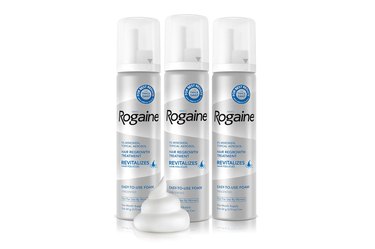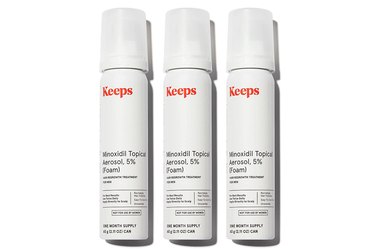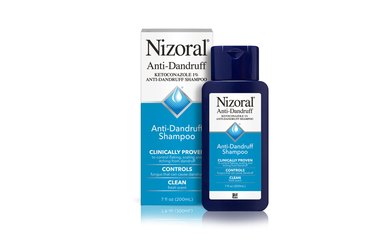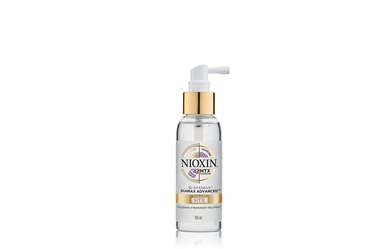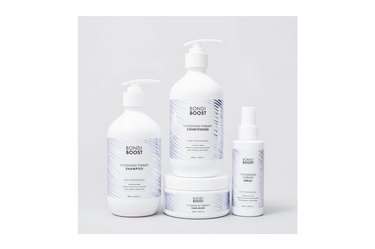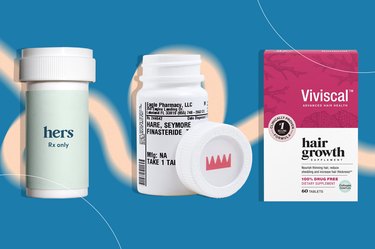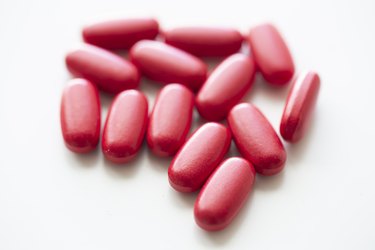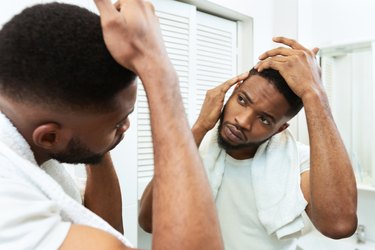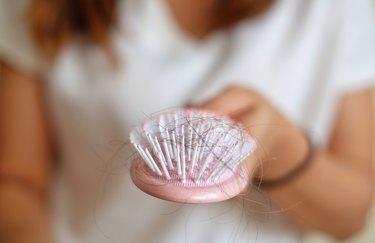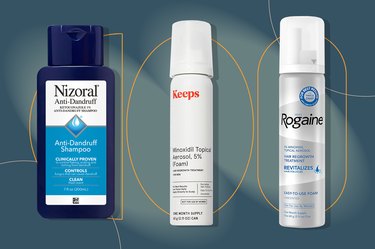
Aging is the most common cause of hair loss in both people assigned male at birth and those assigned female at birth. "Everyone has some degree of it at some point in their lives," confirms Julia Tzu, MD, a board-certified dermatologist and medical director of Wall Street Dermatology in New York City. "It's normal wear-and-tear, like joint pain."
This condition, called androgenetic or androgenic alopecia, is largely genetic and seems to be fueled by high levels of male hormones, says Jerome Potozkin, MD, a board-certified dermatologist in Danville, California, and member of the American Academy of Dermatology.
Video of the Day
Video of the Day
But there are ways to combat it. Here are the best shampoos, foams and solutions for hair loss.
How We Chose
We tapped the experts on hair loss (read: dermatologists) for their recommendations and narrowed down our top picks based on criteria including:
- Effective ingredients
- Safety
- Availability
- Cost
Look for natural ingredients that support hair growth and health. Some ingredients may work better for naturally textured, coily or curly hair types than others.
1. Rogaine
Pros
- Reduced hair loss
- Few side effects
- Comes in a convenient foam
- Available in drugstores
Cons
- Possible scalp irritation
- Effectiveness takes about 1 year
The active ingredient in Rogaine — minoxidil — is probably the best hair-thinning treatment out there, says Jeffrey Rapaport, MD, a board-certified dermatologist and founder of the Rapaport Hair Institute in Englewood Cliffs, New Jersey.
Few studies have been published, however, one landmark March 2004 study in the Journal of the American Academy of Dermatology found almost two-thirds of men had reduced hair loss after using topical minoxidil for a year.
Another landmark April 2004 study in the Journal of the American Academy of Dermatology found topical minoxidil at both 5 and 2 percent concentrations reduced hair loss for women, though the higher concentration was more effective.
While it's been reported that Minoxidil has few side effects, new studies suggest it can cause burning, eczema, contact allergic dermatitis, redness, sinusitis and even dizziness in some users. However, Dr. Potozkin says that only about 10 percent of people will experience side effects, such as scalp irritation. (Talk with your doctor prior to use.)
He also says it takes a while to kick in: Plan on staying with it for a year.
Rogaine, available in drugstores, comes in both solutions and foam. Dr. Rapaport recommends buying the foam (it's less messy).
Buy It
- Men's Rogaine Foam: Rogaine.com ($51.99 for a 3-month supply); Amazon ($52 for a 3-month supply)
- Women's Rogaine Foam: Rogaine.com ($28.99 for a 2-month supply); Amazon ($39 for a 4-month supply)
2. Keeps
Pros
- Foam formulation
- Keeps follicles clean
- Reduced hair loss
- Contains natural ingredients
Cons
- Online subscription only
- Prolonged use required
Minoxidil is also the main ingredient in Keeps' topical hair loss treatment, which is available in both solution and foam formulations. You can purchase an online subscription to get shipments in the mail every three months.
Keeps also offers a shampoo and conditioner to support hair growth, both meant to enhance the results of the topical treatment by keeping hair follicles clean and healthy and making thinning hair look thicker. They contain ingredients like biotin, caffeine and green tea, which some research has connected to hair loss prevention, Dr. Rapaport says.
Keep in mind that, to be effective, hair-loss products require a lifelong commitment. In other words, you have to continue using them in order to keep your results. "It's like brushing your teeth," says Dr. Potozkin. "You have to keep doing it."
Buy It
3. Nizoral Anti-Dandruff Shampoo
Pros
- Anti-dandruff effect
- Contains ketoconazole (for thinning hair)
- Available in drugstores
- Cost effective
Cons
- Not as effective as minoxidil
- Can dry out hair
- 2% concentration available by prescription only
Although billed as an anti-dandruff product, Nizoral also works as a shampoo for thinning hair because it contains a compound called ketoconazole, which may reduce dihydrotestosterone (DHT), a male hormone that drives androgenetic alopecia, Dr. Tzu says.
The anti-dandruff effect may also thicken your hair, given that dandruff can also contribute to thinning, Dr. Tzu adds.
"It's not as effective [as minoxidil], but it's better than nothing," says Dr. Tzu. "It's healthy for your scalp."
And other than potentially drying out your hair, there's little downside. Nizoral is available in 1% concentration over the counter or 2% concentration by prescription.
4. Nioxin Diamax Advanced Hair Thickening Treatment
Pros
- Contains B-vitamin Niacin
- Can increase hair fullness
- Good for age-related hair loss
Cons
- May not work for some people
Like Keeps products, Nioxin shampoo contains minoxidil.
The "Scalp & Hair Treatment" component of the multiple-product system also contains niacin, a B vitamin. A small December 2005 pilot study in the Journal of Cosmetic Dermatology found that applying niacin derivatives topically increased hair fullness in women with female pattern hair loss (basically, age-related hair loss).
This doesn't necessarily mean that shampoos containing niacin will work the same way. Dr. Tzu says that in her experience, "Half of patients who use it are super happy, and the other half don't see a single thing."
5. Bondi Boost Thickening Therapy System
Pros
- Contains biotin
- Contains caffeine for hair growth
- Improves thickness
Cons
- Less effective than biotin capsules
- Multi-product system
- Expensive
Biotin is a B vitamin (B7, to be exact) and one of many ingredients found in Bondi Boost.
People who have a documented biotin deficiency may benefit from supplements, and one 2015 study in Dermatology Research and Practice did report that a tablet containing biotin improved hair loss in healthy women over three months. However, there's little comparable evidence that topical biotin has the same effect, Dr. Rapaport says.
Some Bondi Boost products also contain caffeine, which may help promote hair growth. "It stimulates growth by blood vessel dilation. There's good scientific evidence for caffeine," Dr. Rapaport says.
The system includes a thickening shampoo and conditioner, therapy spray and hair mask.
Buy It
Bondi Boost Thickening Therapy System: BondiBoost.com ($100)
6. Revita High-Performance Hair-Stimulating Shampoo
Pros
- Contains biotin, ketoconazole and caffeine
- Decreases hair loss
Cons
- Expensive
- Topical biotin is less effective than biotin capsules
Several products on this list contain biotin along with other ingredients that may promote hair growth. This shampoo includes biotin along with ketoconazole and caffeine.
Shampoos in general may provide another, often overlooked benefit. "The act of shampooing increases circulation in the scalp," says Dr. Rapaport. "Increased circulation will lead to a decrease in hair loss and possibly an increase in regrowth."
A March 2019 study in Dermatology and Therapy backs this up, with almost 70 percent of survey respondents who massaged their scalp 11 to 20 minutes a day over about six months reporting either a cessation of hair loss or regrowth.
Buy It
Revita Hair-Stimulating Shampoo and Conditioner: Amazon ($60)
What to Know Before You Buy
1. Look for Active Ingredients
Some ingredients have more evidence supporting their use as hair-thinning treatments than others. These include:
- Minoxidil
- Ketoconazole
- Biotin
- Caffeine
- Niacin
Ginger and green tea may also provide some benefit, Dr. Rapaport says. Some ingredients may work better for naturally textured, coiley and curly hair types — such as castor oil, peppermint oil and shea butter.
2. Timing Is Key
If you are completely bald, chances are that none of these remedies will help you, says Dr. Potozkin. The earlier you start treatment, the more likely you are to see results.
3. More Research Is Needed
Much of the scientific research showing that these ingredients work for hair thinning involved oral formulations like tablets, not topical formulations. You can't be sure the benefits extend to topical formulations, which are applied and not ingested.
Minoxidil is available as a prescription pill medication called finasteride (Propecia), another popular and effective hair-loss treatment.
4. See a Doctor
Although age-related androgenetic alopecia is the most common type of hair loss, there are others. Alopecia areata, for instance, is an autoimmune disease, while physical and emotional stress can also trigger alopecia.
Before starting any treatment, check with a dermatologist about what's causing your hair loss so you can target treatment. A doctor can do blood tests to check for irregularities in iron, thyroid and hormone levels, says Dr. Potozkin. You can also ask him or her about other treatments, such as light devices.
- National Library of Medicine: “Androgenetic alopecia”
- American Academy of Dermatology: “Hair loss types: Alopecia areata overview”
- Drug Design, Development and Therapy: “Minoxidil and its use in hair disorders: a review”
- Journal of Cutaneous Medicine and Surgery: "Incorporating Medical and Surgical Dermatology: “Safety of Topical Minoxidil Solution: A One-Year, Prospective, Observational Study”
- Journal of the American Academy of Dermatology: “A randomized, placebo-controlled trial of 5% and 2% topical minoxidil solutions in the treatment of female pattern hair loss”
- American Academy of Dermatology: “Hair Loss: Diagnosis and Treatment”
- Harvard Medical School: “Biotin – Vitamin B7”
- Dermatology and Therapy: “The Role of Vitamins and Minerals in Hair Loss: A Review”
- American Academy of Dermatology: “Hair Loss Resource Center”
- Journal of the American Academy of Dermatology: "A one-year observational study with minoxidil 5% solution in Germany: results of independent efficacy evaluation by physicians and patients"
- Dermatology and Therapy: "Self-Assessments of Standardized Scalp Massages for Androgenic Alopecia: Survey Results"
- Rx List: Minoxidil Topical
Is this an emergency? If you are experiencing serious medical symptoms, please see the National Library of Medicine’s list of signs you need emergency medical attention or call 911.
